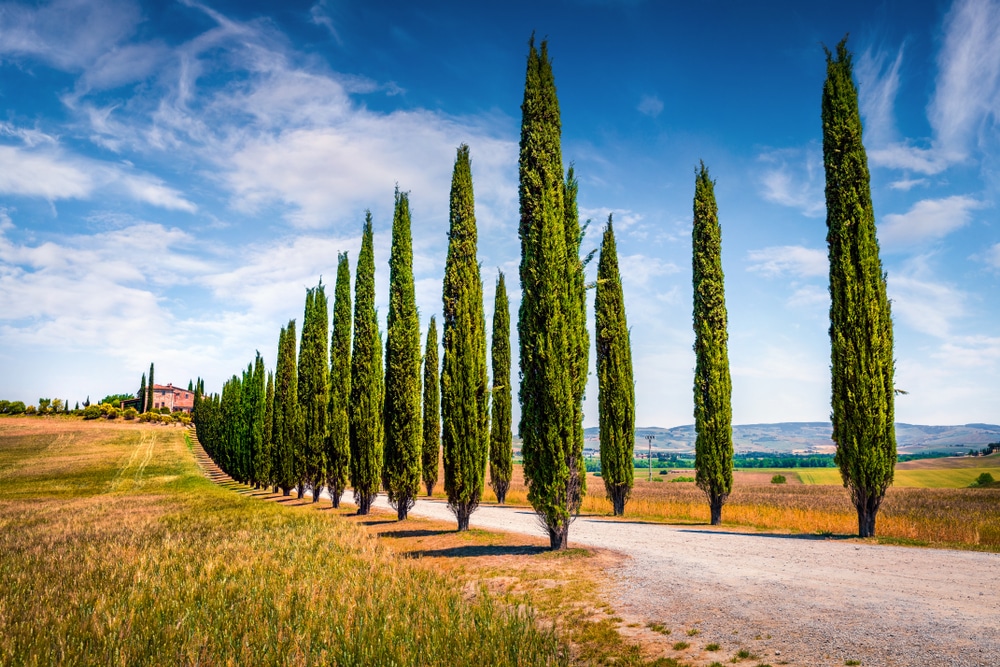Some plants are worth the trouble, while others take up all your time and resources. In the case of Italian cypress trees, the level of care is a mixed bag.
These tall, narrow trees carry a graceful presence and aesthetics that works for any land, but only dedicated gardeners can maintain their quality.
This article focuses on the pros and cons of tending Italian cypress trees.
What Is an Italian Cypress Tree?

Also known as a Pencil pine, an Italian cypress is an elongated tree species native to Mediterranean regions. They work for both ornamental plants and topiary purposes.
People associate these trees with road pathways and areas with enough land to support numerous columns. They can grow up to 30 meters with a trunk diameter of 0.5 meters and tiny leaves open to hedge work.
What Are the Pros of an Italian Cypress Tree?
Before planting an Italian cypress tree, you should know what it can offer to your land.
Here are some benefits of owning this type of tree.
Evergreen
Italian cypress is a form of an evergreen tree that adds beauty to any garden. Even in the gloomiest winters, evergreen trees can withstand harsh conditions and maintain their gracefulness.
Italian cypress trees enhance the ecosystem by providing shelter for small birds and nearby wildlife. Their short leaves and tight, narrow bodies can keep nesting grounds safe from predators and terrible weather conditions.
These trees also serve as a windbreak. During windy seasons, a column of cypress trees can protect a vegetable crop or items susceptible to high winds.
Fire-Resistant
Italian cypress trees are surprisingly resilient to high temperatures due to their Mediterranean origins.
The structure of their leaves retains water and holds enough to become fireproof. The leaf cuticles are thick, and the opening pores center around the inner surface, keeping the contained water secured from heat or evaporation.
These trees have a natural adaptation to warm climates. You don’t have to worry about fires, droughts, or dry heat as long as they carry a high water content.
Rapid Growth
You don’t have to wait long for these Italian cypress trees to reach their length. Every year, they can grow 3 feet taller and provide their natural services as soon as you plant them.
Depending on your preferences, trimming these trees is required with minimal care. You can shape the size and height to fit your ideal garden or landscape.
What Are the Cons of an Italian Cypress Tree?
Some trees can thrive on different types of land, but it’s not easy to maintain.
Here are some reasons you wouldn’t want an Italian cypress tree.
Diseases
Growing Italian cypress trees in the wrong climate conditions can lead to disease.
Too much water in the soil can rot the roots. After an extended period, the branches begin to wilt, change into brown leaves and eventually die.
Canker fungi and bacterial infection are other possibilities that kill a cypress tree. Without treatment, several areas are discolored and become dry and brittle.
Unsuitable Size
If you don’t have the space to maintain an Italian cypress tree, consider getting a smaller plant.
The height of these trees can obstruct views and overshadow a house or garden.
Cold Weather
Italian cypress trees don’t survive in cold climates. The growth slows down, and they become prone to pests and diseases.
These trees have a higher chance of survival in California or Mediterranean regions with warm weather conditions.
Conclusion
Italian cypress trees are great plants to keep under the right conditions. They are often used as privacy trees to mark the boundary of a property and block the neighbors view. Consider your land size and commitment when deciding to plant these trees.
